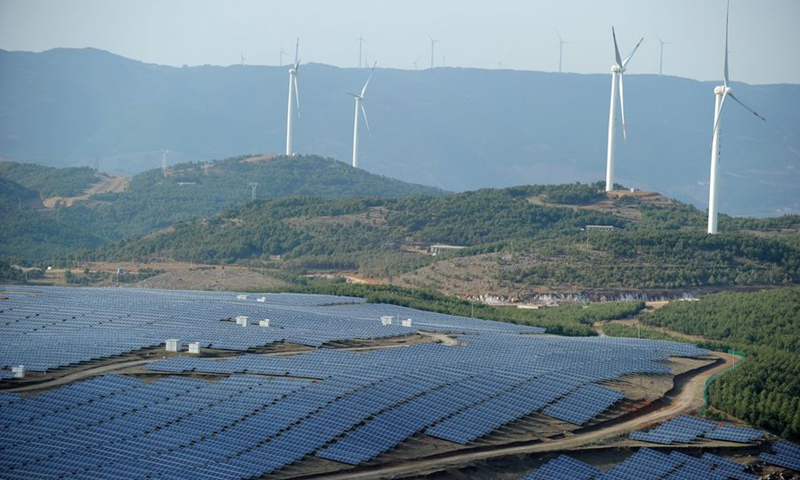
Photo shows the Pingjing photovoltaic (PV) power station and Dahaizi wind power station in Weining county, Southwest China's Guizhou Province. File Photo: Xinhua
By 2025, a relatively complete energy standard system that can effectively support and lead the green and low-carbon transformation of energy will be initially established, China's National Energy Administration (NEA) stated in a notice on Sunday, as the country works toward its "dual carbon" goal.
The notice came as sweeping top-down efforts have been rolled out in China while the country strives to attain its carbon dioxide emissions peak before 2030 and achieve carbon neutrality before 2060.
Serving as clear guidelines for the country's carbon reduction target, the notice stated that an energy standard system that can effectively support and lead the green and low-carbon transformation of energy will be initially established by 2025, and that energy standards will be transformed from a quantitative scale to focus on quality and efficiency.
The new standard will look at further prompting the safety and adequate of energy supplies while working to advance the energy supply chain and low carbon levels, Lin Boqiang, director of the China Center for Energy Economics Research at Xiamen University, told the Global Times on Sunday, who applauded the latest announcement.
The new standard will be formulated to support renewable energy such as solar and wind power, which includes the establishment of new forms of power generation, accelerating the improvement of a new energy storage standard system, the NEA said.
Enhanced support will be provided for the development, construction, grid-connected operation, consumption and utilization of large-scale wind power photovoltaic bases and distributed energy sources, according to the NEA.
The NEA also pledged to formulate a number of emerging technologies and technical standards related to carbon emission reductions throughout the country's industrial chain while improving the organizational framework for relevant standards, and achieving full coverage of standards linked to carbon peaking industrial processes in the energy field.
The transformation of China's energy production structure is accelerating, with the proportion of clean energy continuing to increase.
The latest report released by the National Bureau of Statistics on Saturday shows that in 2021, China's energy consumption per unit of GDP had decreased by 26.4 percent compared with 2012 levels, with an average annual decrease of 3.3 percent, equivalent to saving about 1.4 billion tons of standard coal, according to media reports.
In 2021, the installed capacity of non-fossil energy power generation exceeded that of coal power for the first time, with an installed capacity of 1.12 billion kilowatts, accounting for 47 percent of total installed power generation capacity, the report said.
China's installed capacity for hydropower, wind power and solar power is in excess of 300 million kilowatts, ranking first globally for consecutive years.
The new standard will boost and standardize the comprehensive utilization of resources and the improvement of energy efficiency, Lin said.




